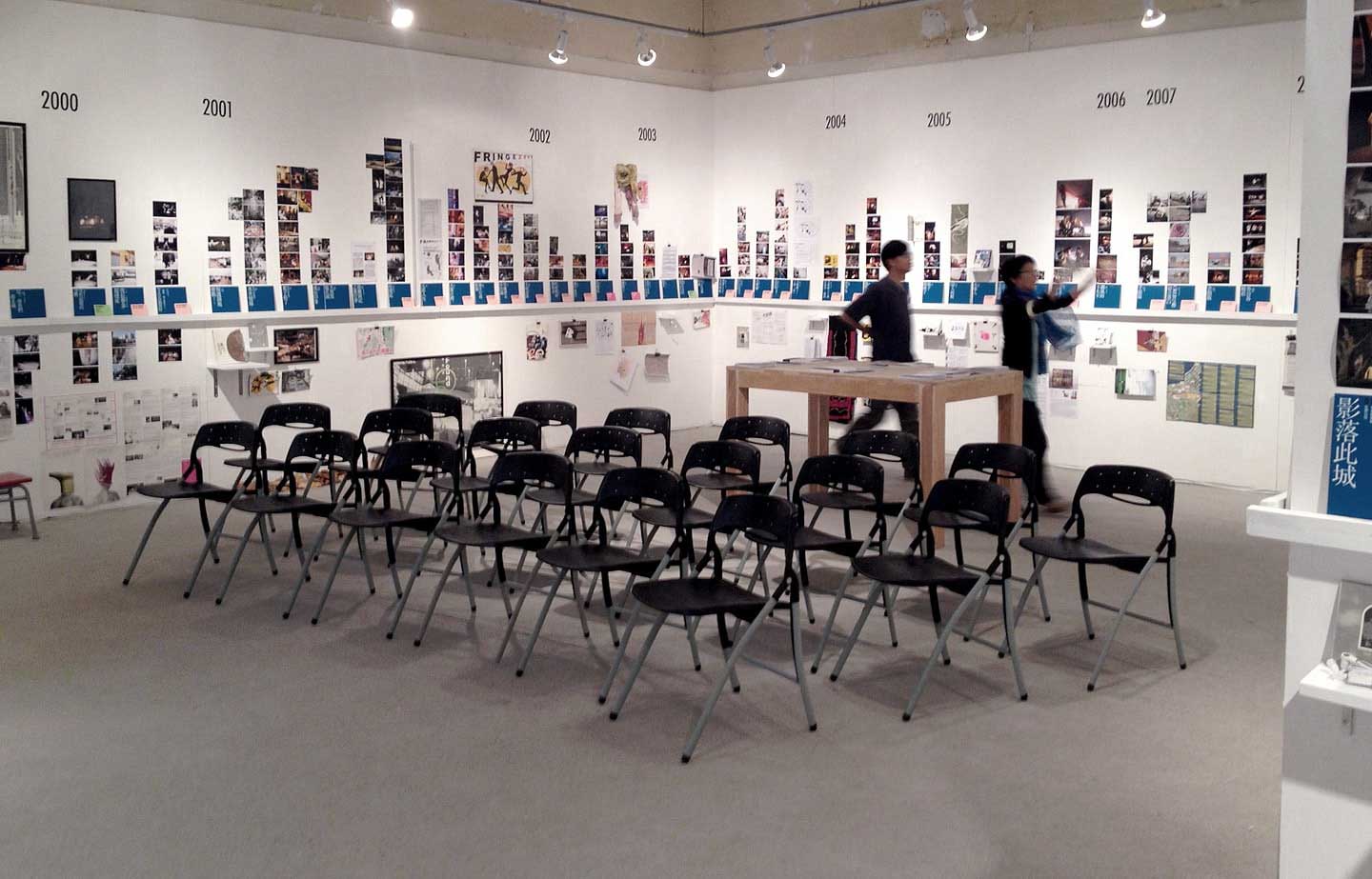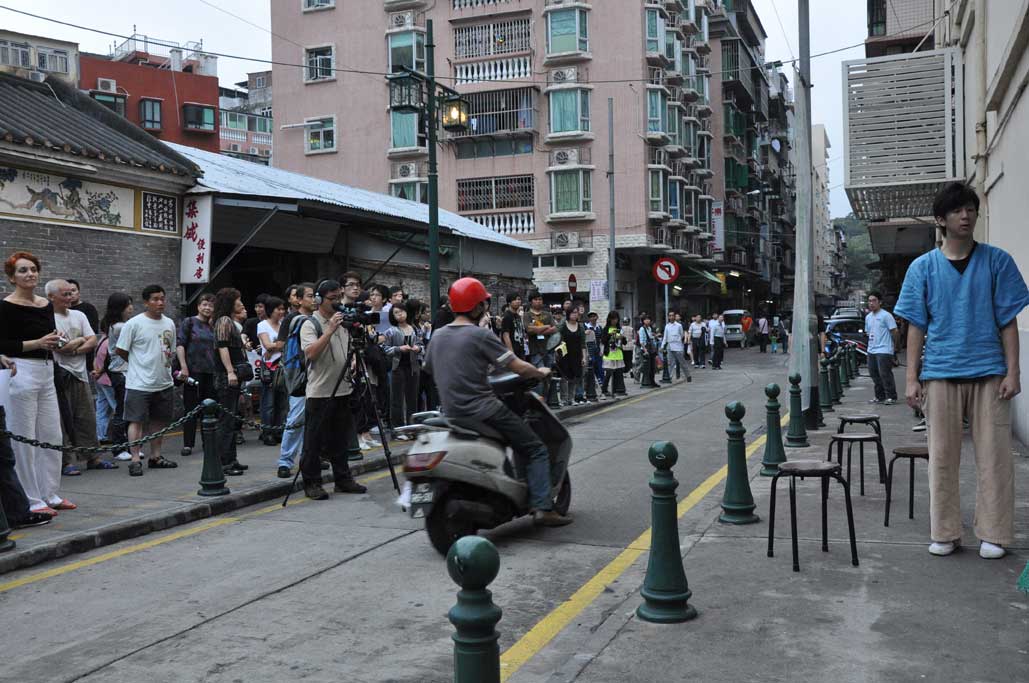Grassroots Curating in Asia
Today, as we are so accustomed to watching plays in a theater, we often overlook the fact that this cultural consumption behavior actually implies a particular spatial order introduced by modern theatrical semiotics. With the advent of theater productions that highlight experiential, participatory, and public engagement, as well as collective walks, theater seems to open up to public spaces beyond the confines of traditional theatrical architecture. The question lies in whether this serves as an antidote to theater modernity and the subversion of its spatial production, or if it merely perpetuates existing patterns of cultural consumption. In reflecting on the plays produced by the Macau-based performance art group Step Out (2001–), particularly those that employed performance walks to activate the sensual experiences of the audience members, I realized that this method holds potential for de-familiarizing the spaces around us and even sheds light on liberatory narratives for theater.
While the Chinese name of the group (literally translating to “footsteps”) aptly captures the performance walk format, it wasn’t until the 2013 archival exhibition showcasing Macau’s 20-year history of site-specific theater practices—titled Strolling and Catching a Show, a phrase borrowed from Cantonese slang—that the art group’s director, Mok Sio-chong, explicitly verbalized the format and connected it to the city’s rich legacy of site-specific theater. In related publications, Mok traces Macau’s site-specific theater back to the eve of the Sino-Portuguese Joint Declaration in 1998, with plays by groups like Hiu Kok Drama Association (1975–) and Comuna de Pedra (1996–) frequently engaging in various outdoor sites in Macau. After the city’s return to China, the Macau City Fringe Festival took charge of producing site-specific plays. The early 2000s saw significant changes in the postcolonial city’s strategy in spatial production, influenced by the expansion of the gambling industry, the easing of tourist travel for mainland citizens, and the application of Macau’s historic sites for World Cultural Heritage status. This era of rapid transformation has since thrust its residents into a new reality marked by the uncertainties of the island’s present and future, all under the shadow of the handover.

Tracing the artistic trajectory of Step Out, their earliest attempt to engage the audience in a semi-performance walk setting was in No Eyes See (2003). During this production, blindfolds were handed out to the audience while they were transported by shuttle bus. Once the bus crossed the Macau-Taipa Bridge, the audience had no idea where they were headed. Upon arriving at Taipa Pequena Lookout, the audience members were invited to touch and feel the surroundings, blending their experiences with local Taipa legends that Step Out had woven together through archival research and oral history interviews. Step Out’s first full integration of a performance walk was in The Taipa Story, She Tells (2004). This research-based production focused on actress Kate Leong’s three-generation family history, taking the audience to historical sites tied to her grandmother’s migration to Macau, her parents’ experiences as second-generation Portuguese and Chinese, and Leong’s own story. The script was meticulously crafted from extensive archival research and oral history interviews. The live performances and spatial choreography employed interwoven narratives and contrasting spatial storytelling, blending oral history with fictional elements and even long-lost spaces in memory. For instance, the actors would describe the original appearance of a location, contrasting it with its current, vastly different state, creating a vivid contrast between the past and present.
The first Step Out performance walk I attended was Lin Kai With No River (2009), set in the old San Kio neighborhood, where the titular creek was highlighted by its disappearance. The audience first gathered at Poor Space, a studio on Avenida de Almeida Ribeiro run by Step Out. After visiting the indoor exhibit, each of us received a treasure map of San Kio, marked with questions to answer as we navigated the narrow alleys. While the questions highlighted easily overlooked details, they guided us through small gestures and ordinary livelihood encounters. Various street performances along different locations referenced the creek that once flowed through the area in its now-haunted form. Immersed in the narrow, ancient alleys of this vibrant neighborhood, we experienced a moist, intimate feeling that brought us closer to the community. These sensory experiences not only engaged us in observing the city but also challenged our understanding of theatrical frameworks.

Speaking of studio spaces like Poor Space, it is these privately run small theaters, along with site-specific theater plays, that sustained Macau’s cultural manifestation during the long interval between the opening of the Macau Cultural Center in 1999 and the inauguration of the Black Box Theater in the Old Court Building in 2014. Mok once characterized these privately run small theaters, typically located in old districts outside tourist destinations, as distinct from the Cultural Center or large casinos in reclaimed areas. He further noted, “These old neighborhoods feature narrow streets, a close-knit community, a much slower pace, and vibrant local life.”1
Mok first truly sensed the political aspect of collective walking during a performance of The Rise and Fall of Long Tin Troupe (2010). On that day, over fifty audience members participated, but they encountered roadblocks and detours due to a traffic jam. Following a large puppet, a flag, and a portable sound system, the group wandered through several streets. Some scenes were silent, evoking a ritualistic feeling of collective unconscious walking through urban spaces. The now-disappeared Long Tin Opera Troupe was a Cantonese opera troupe, and both the theater and the ancient village are long gone. In 1847, during his tenure as Governor of Macau, João Maria Ferreira do Amaral implemented colonial expansion policies, imposing gambling taxes and opening roads. Long Tin Village, then a rural area outside Macau, suffered greatly from these expansions, forcing villagers to relocate their ancestral graves. Despite Amaral’s assassination, in which Long Tin villager Shen Zhiliang played a significant role, the village’s struggles continued. in 1879, the Portuguese occupied Long Tin Village and exhumed Shen’s tomb. Over time, the name Long Tin faded into oblivion. Performing near Amaral Square, a well-known site overshadowed by its colonial legacy, Long Tin chose a forgotten route to demarcate the disappeared boundary of the village. Through audio recordings and visual dislocations, the performance interwove poetic dialogue and fragmented puppets to depict the brutal, bloody history of Shen’s assassination of Amaral, avoiding sensationalism. This blend of amnesia and memory might emerged as the underlying theme.
In 2011, my travels brought me to Macau twice: initially for a screening and discussion on Taiwan’s freshly passed controversial Hualien-Taitung Area Development Act, and later as a guest critic at the Macau City Fringe Festival. During this period, Macau was actively engaged in planning 350 hectares of new urban reclamation. It was then that I engaged with fellow friends of Step Out, exploring potential projects on ecological critique and collaboration between the groups in the two cities. This led to the Act For the Sea: Marine Culture Exchange Program (2012), which I co-curated with Mok. The program brought together NGOs, writers, and artists from Macau, Hong Kong, and Taiwan, featuring a series of events including beach cleanups, lectures and documentary screenings on ocean ecology, as well as performance walks that combined guided tours, installation displays, theater, and music performances. A standout component of this initiative was the Exploring the Original Coastlines: Macau Peninsula Art Tour. Crafted in partnership with the Root Planning Cooperative in Macau, this tour laid out two distinct paths along the peninsula’s pristine coastline. The first journeyed from the southwest to the northeastern core of the peninsula, enriched by performances from Comuna de Pedra and Dirks Theatre, an art installation by Sandy Leong Sin U, and a concluding film screening by Taiwan’s Kuroshio Ocean Education Foundation. The second route ventured southward from the western inland, highlighted by a Step Out performance, a collaborative display by Hui-Chun Chang from Kuroshio Foundation and Macau’s Lam Ka Pik, and culminating in live musical tribute to the ocean by Taiwanese musician Snow Huang, local poet Un Sio San, and visual artist Waipeng Leong.
Despite the packed itinerary, the tours were intentionally loosely structured, particularly the guided tours by Root Planning Cooperative. These small but significant pauses allowed for potential shifts in the perception of time, balancing knowledge absorption with sensory engagement. Moreover, the events encountered were imbued with limited intensity, serving as conduits for audiences to gain renewed perspectives on the cityscape. In other words, the liberation of narrative stemmed from loosening narrative consciousness, allowing participants to invent their own open-ended stories by providing space to perceive alterity around us. Through their engagement in curating, which brought elements from site-specific theater, Step Out began to experiment with what I perceive as a shift toward what could be termed “non-performance.” This allowed Step Out to further develop from the unpredictability and serendipity inherent in participatory experiences of site-specific theaters, thus fostering a nuanced interaction between the audience and performers. This approach initiated an aesthetic regime that recentered the audience’s perspective, creating a spatial poetics where narratives, both grand and subtle, interwove to foster diverse interpretations beyond any single story.
Later on, Step Out continued producing performance walks such as The Love Songs of Praia Grande (2013), Curry Bone’s Travel 2019 (2019), and Carlos 1 (2020, 2022) directed by Tou Kuok Hong. On my most recent visit to the city, the Light Rapid Transit was already in operation. Unlike the familiar names of bus stops that reflect everyday life, the cabin announcements of each LRT station—from Airport, East Asian Games, and Stadium to Jockey Club—resonated with aspirations of ambitious development and territorial expansion. It was only when I disembarked at the last stop, Barra Station, and walked toward a friend’s home that local spots like Barra Temple and Hawker Street slowly revived my long-dormant memories of Macau. Across the strait, the brightly lit high-rises of Zhuhai and the flashing giant fonts of commercial taglines provided a striking contrast during the brief fifteen-minute walk, filled with conflicting sensations. Today, the logic of urban spatial production has shifted from homogeneous integration to one of variation and distinction. Increasing numbers of museums, cultural clusters, and stylish cafes seem to meet our need for diversity while actually fulfilling urban metabolism. From the perspective of the politics of sensibility, the practice of these performance walks is about estranging the city from the theaters and vice versa, disrupting the continuity of city governance and the velocity of consumerization. It aims to extend differences, highlight urban asymmetries, and reclaim individual sensibilities.
1 B Hiu Kok Theater, Theater Farmers, Comuna de Pedra, Theater Horizon, and Audio-Visual CUT Association also managed their own spaces. Mok Sio-chong, New Century Chinese Theater in Macau (Revised Edition), Macau: Cultural Affairs Bureau, 2019, p. 22.
2 Mok Sio-chong and Jane Lei, “The Politics of Vision and Navigation: Site-specific Theater in Macau Revisited,” in Performing Arts Forum, vol. 24, Macau: Macao Theatre Culture Institute, 2016.
Share
Author
Wu Sih-Fong is a theater critic currently based in Hualien, Taiwan. He engages with theater practice through writing and editing, alongside occasional curatorial and production projects. His research focuses on alternative interpretations of theater genealogy, its ecology and institutional factors such as the operation and production of theater performances outside urban areas, as well as the mechanisms of review and medium-sensitive criticism. His recent curatorial works include “All There is to Say is Here—Chinese Malaysian Literary Adaptation Theater” (2015), “Co-learning Lecture 03: ‘Critical Point Theater Phenomenon’ and Its Time” (2017), and “The Method of the ‘Collective’—Forum on Theater and Society” (2017). His recent theater production projects include the 2nd Returning to the Island of South: Performance Art Festival (2017), the 2nd Waterfield Studio Performance Art Festival (2018), Blacklist Studio’s “Hermeneutics of Hamlet Machine Conceptual Theater—Image Project (Phase 1)” (2018), and “Southview—Performing Arts Review Project” (2019). He is the editor of Outsider: Selected Plays of Koh Choon Eiow (co-edited with Cheng Yi-Chen; 2019) and Khí-lo̍h-thia̍p Jī: Folk Parade and Contemporary Theater (2022). He also widely collaborates with theater companies in editing their printed matters.








